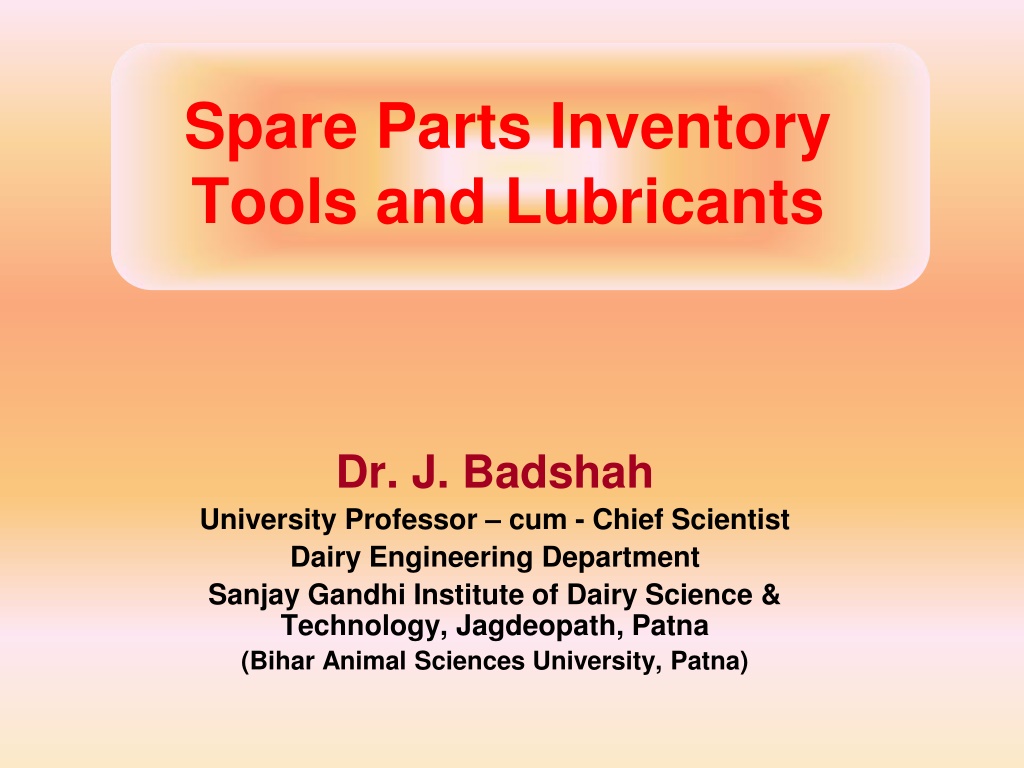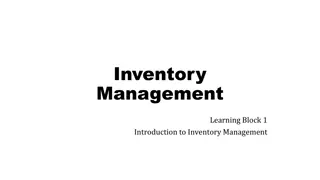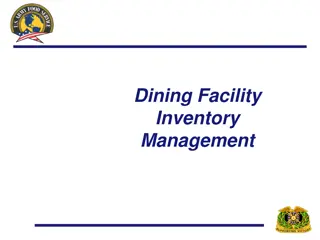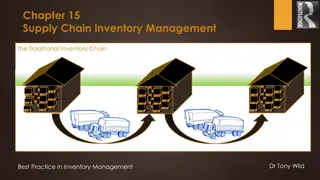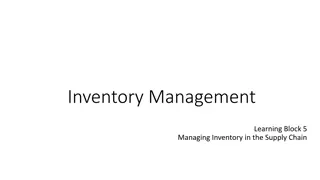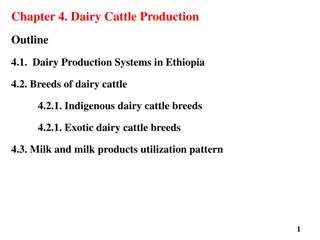Effective Spare Parts Inventory Management Strategies for Dairy Plants
Importance of spare parts inventory in dairy plants, recommendations for inventory management, and nine tips for efficient inventory control, including ABC analysis for labeling critical components. Proper spare parts management helps prevent downtime and reduce unforeseen costs in dairy plant operations.
Download Presentation

Please find below an Image/Link to download the presentation.
The content on the website is provided AS IS for your information and personal use only. It may not be sold, licensed, or shared on other websites without obtaining consent from the author. Download presentation by click this link. If you encounter any issues during the download, it is possible that the publisher has removed the file from their server.
E N D
Presentation Transcript
Spare Parts Inventory Tools and Lubricants Dr. J. Badshah University Professor cum - Chief Scientist Dairy Engineering Department Sanjay Gandhi Institute of Dairy Science & Technology, Jagdeopath, Patna (Bihar Animal Sciences University, Patna)
Introduction to spare parts and Inventory Importance of spare part Programmes i. To upkeep the all machineries for production. ii. Practically no uniform standard of equipments in dairy plant due to manysuppliers iii. Necessary to keep various types of spares iv. To contain consumable items such as gaskets, standard lubricants and paints v. To keep three basic groups of engineering accessories: a. Equipment spare parts. b. Complete components. c. Pipes and fittings, bolts, nuts and washers, bars and plates of different metals, electric components and other general types of engineering accessories.
Recommendations of Inventory The quantities to be kept should ensure regular and trouble-free plant performance without overstocking the stores. The selection of spare parts kept in the store is based on the manufacturers' recommendations and on the plants own experience of local operating conditions. Relatively steady demanded parts must be available i. Rubber gaskets for milk pipes, plate gaskets for heat exchangers, graphite and rubber sealing for pumps, electric relays and special bulbs, selected bearings, springs and automatic switches, etc. ii. Some consumable items such as automatic recorder charts and inks, special lubrication components and even packaging materials to which packaging machines are particularly sensitive, such as aluminum capping foils for bottling.
Recommendations of Inventory It is much more difficult to decide on items which are used sporadically. The demand for them is erratic and only experience can tell what deserves to be stored in the plant. After all, poor spare parts control and planning can lead to inefficient inventory storage and a shortage of parts when you need them most, which causes unplanned downtime and unforeseen costs. For the overall success of your business, it s in your best interest to invest in optimized spare parts inventory management, starting with these nine tips.
9 Tips for Inventory control 1. Choose a Method for Labeling Critical Components (ABC analysis and XYZ analysis) i. ABC analysis is an approach for classifying inventory based on the items consumption value, wherein the consumption value is the total value of the item consumed over a specified time period. ii. A parts have the highest consumption value, B parts have an intermediate consumption value, and C parts have the lowest consumption value. iii. ABC analysis involves reviewing inventory items, then labeling them with an A, B or C: iv. A parts make up about 80 percent of all parts used, but account for 20 percent or less of inventory stock. v. B parts make up about 25 percent of usage, but account for about 30 percent of inventory stock. vi. C parts make up about 5 percent of usage, but account for about half of the inventory stock.
9 Tips for Inventory Control 2. Balance Inventory Volume With Sawtooth Diagrams It can help you contextualize how your inventory stock is depleted and replenished over time. The y axis of the diagram should represent the inventory level, while the x axis should represent time. The lines that make up the saw teeth should represent the steady decrease of inventory over time. Each peak represents the maximum inventory level, and the distance between each peak represents the amount of time between shipments, otherwise known as the cycle time. Additional markers within your sawtooth diagram should represent the reorder point and lead time. In order for your sawtooth diagram to be an accurate reflection of your spare parts inventory volume, you must first establish minimum and maximum inventory levels for each spare part.
9 Tips for Inventory Control 3. Keep Your Bill of Materials up to Date Your bill of materials (BOM) is the winning formula for manufacturing an end product that s light-years ahead of its competition. As a result, it s vital that you keep your BOM up to date in order to prevent inventory inaccuracies and spare parts shortages and to better plan for preventative maintenance or servicing. Take time to review your BOM on a regular or semi-regular basis to add or remove parts from it as needed. 4. Calculate Optimal Economic Order Quantity According to Investopedia, economic order quantity (EOQ) is the ideal order quantity a company should purchase for its inventory given a set cost of production, a certain demand rate, and other variables, and is done to minimize inventory holding costs and order-related costs. You can use EOQ to determine the quantity of spare parts you need to order based on annual demand by using the following formula:
9 Tips for Inventory Control 5. Develop a Standard Work Order Process There are a few things you can do to make your work order process more efficient: Hold employees accountable for following standard procedures Define consequences for failure to file a formal work order Introduce automated systems to reduce manual paperwork Simplify your process wherever possible Invest in quality employee training 6. Focus on Inventory Control During Employee Training by selecting one that covers both standard processes and procedures, as well as any technology your business might use to optimize spare parts inventory management.
9 Tips for Inventory Control 7. Perform Cycle Counts on a Regular Basis Cycle counts are more convenient than total inventory counts because they don t interfere with normal business operations, which means they can be performed on a more frequent basis. In order to ensure a successful cycle count, set the following parameters: Which spare parts inventory group do you need to cycle count (A, B, or C)? How many SKUs do you need to cycle count? Who will be responsible for the cycle count? How many people will be responsible for the cycle count? How frequently do you need to perform cycle counts for the inventory group in question?
9 Tips for Inventory Control 8. Make Spare Parts Easily Accessible Make it easy for your employees to submit work orders and pull parts from warehouse shelves by storing spare parts within a centralized inventory. With a clear idea of where everything is located within your warehouse, you can better guarantee overall inventory accuracy. 9. Invest in a Quality CMMS A computerized maintenance management system (CMMS) can make it easier to implement some of the spare parts inventory management best practices listed above, as well as to analyze spare parts, to optimize reorder points, and more. The real challenge, however, is to find a CMMS that can do it all. With Parts Forecasting, you can: Improve spare parts inventory turn time Reduce inventory inaccuracies and shortages Eliminate service delays due to out of stock items Reduce inventory costs Increase service satisfaction and first-time fix rates
Lubrications of Machineries The principal causes of equipment breakdown and actions to be taken i. No lubrication or unplanned lubrication ii. The best solution is to have a regular lubrication schedule, iii. A lubrication chart for each machine iv. Setting the frequency of lubrication v. Type of lubrication and lubricants needed and place of lubrications vi. Light, high speed bearing will require a light oil, whereas a heavy duty, low speed bearing will require heavier oil. vii. Bearings that are operated at high temperatures must have a lubricant specially adapted for this use, just as those bearings that operate at extremely low temperatures will require zero oil. viii. Many dairy plants have rather high humidity and for that reason the moisture problem should be considered. Certain lubricants are available that resist rusting and corrosion due to moisture
Lubrication ix. There are also oils that resist emulsification with water and are advantageous for flooded systems of lubrication where gears and chains run in oil. x. The most tightly enclosed oiling system will with time allow moisture to accumulate. It is essential to occasionally check the oil in an enclosed drive to make certain it is not contaminated with water. Usually the water will collect at the bottom and may be drawn off easily. Benefits of Lubrication Less production downtime with all its related in-plant savings and customers' benefits. Fewer major overhauls, hence less costly repair bills. Fewer repetitive repairs. Less spoilage and product waste, hence a factor in better quality control.
Benefits of Lubrications Postponement replacement of physical plant and/or equipment/ because of better conservation of assets and increased life expectancy. Requirement of less standby equipment thus reducing capital investment. Shift from inefficient breakdown maintenance to less costly scheduled maintenance/ hence better work control and saving due to Less plant outage and reduced maintenance costs. Better spare parts control, leading to minimum inventory yet having appropriate spares at hand when needed. Greater safety for workers and improved protection for plant. Reduced utility and fuel costs. Lower unit costs of manufacture. Greater certainty in meeting production schedules. . or elimination of cash outlays for premature
